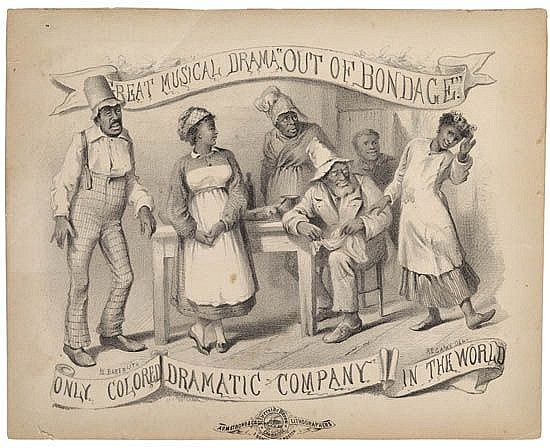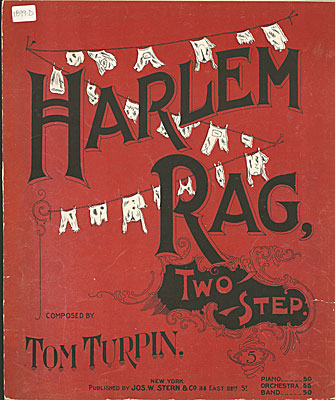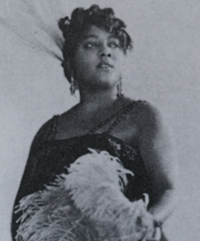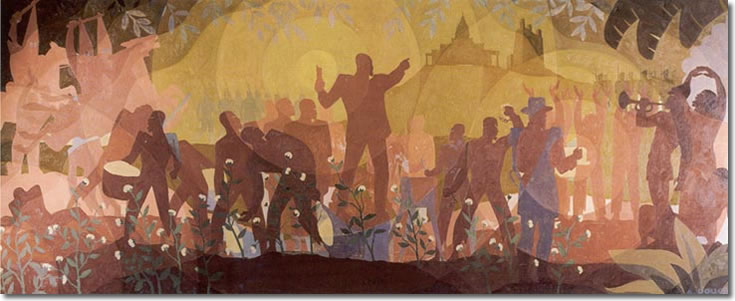The years between Reconstruction and World War 1 witnessed an amplified and varied African American presence in the public sphere. During the last years of the 19th century a dramatic rise of “public amusements” occurred that was marked by an explosion of commercialized leisure that indexed America’s turn from Victorian sensibilities. Advances in technology, the emergence of cultures of consumerism, and an unprecedented black mobility together with increasing educational opportunities created a social milieu in which black musicians became a strong presence in the culture industry. As the specter of minstrelsy still prevailed in the land, many black musicians would have to engage its structures and practices in order to gain opportunities in the newly emerging mass-market enterprise. Black musicians would continue to build a cultural nationalism through both Afrological and Eurological expressions.
For the African American performer after the Civil War participation in theater could involve three related forms: musical theater, minstrel shows, and vaudeville. The black musical theater tradition began when the Hyers Sisters, two women who had already built careers on the concert stage, created together with the white writer Joseph Bradford, the musical comedy Out of Bondage in 1876. The first of many such productions, their plots included plantation scenes and topics of racial progress within a format that featured plantation songs, ballads, operatic numbers and folk dances.
The minstrel show became a reliable route to financial security for many black musicians, even those trained in classical music. What was often billed as Ethiopian minstrelsy created the most ample opportunities for African Americans to break into show business with over 100 black minstrel troupes formed between 1865-1890. Their entertainment comprised a traveling hour and forty-five minute variety show consisting of three general categories of songs: ballads, comic songs, and specialty numbers. Representative shows featured singers and a small ensemble of instrumentalists and performed the works of such black songwriters as James Bland, Gussie Davis, Samuel Lucas as well as Stephen Foster, a white writer. The repertory of the typical black minstrel show included religious songs and operatic arias as well.
Broadly speaking, the social categories of “folk” (a group’s continuity with a constructed ancient past), “mass” (accessibility and value through sales), and “art” (edification and understanding through specialized training) began to calcify in the public sphere. An important development as well concerned the partnership of various elements of the music industry at this time. The three primary revenue streams—publishing, live music, and recording—became consolidated and over the years each would take and lose the lead in earnings for a musicians. One thing would become crystal clear, however: promotions would always be central to the success of each. The paradigm was set earlier in the middle of the 19th century when the great impresario P.T. Barnum—mostly known today for his circuses—promoted the Swedish operatic soprano Jenny Lind’s solo tour to the United States in 1850. Through clever advertising, Barnum instilled the desire for not only Lind’s stellar musicianship but also her “chaste” personal lifestyle. One could experience, consume and be edified by each in her performances, or so the advertising claimed. What we see here is the beginnings of a remarkable turn in which artifice was collapsed with the supposed inner subjectivity of performer. It is a paradigm present even in today’s performers. “Lindmania” swept the country.
The new technology of recording, pioneered by Thomas Edison in 1877, began as an experiment to reproduce the spoken word and soon became a way to disseminate music. When George W. Johnson, a former slave, recorded “The Whistling Coon”in 1890 for the New Jersey Phonograph Company, it made him the first African American recording artist. As a child he was assigned to be the “bodyservant” to his master’s young son to whom he was close in age. Johnson sat in on his young master’s flute lessons, imitated the notes, and could eventually whistle any tune he heard. He was “discovered” as an adult by the New Jersey Phonograph Company that was looking for something “cheap and loud.” Johnson recorded a “coon song” written by the white vaudevillian Sam Devere and filled with lyrics poking fun at physical stereotypes of African Americans. Despite the utterly distasteful lyrics of “The Whistling Coon,” which made him famous and, perhaps, even infamous, one can explain Johnson’s art as the humanizing of technology. Jazz vocalists in the next century would create scat singing using the same principles. The accompaniment of the song is performed in the “rag” style, a syncopated piano form that was sweeping the nation.
In the 1890s, the term ragtime embraced a wide range of music, including syncopated coons songs from minstrelsy, arrangements of these songs for large ensembles, any syncopated music for dancing, and solo piano music. As early as 1876 one finds reference to a stylistic precursor named “jig time” in the musical theater production Out of Bondage. Describing an energetic music played on the piano, it was also known as “jig piano,” which simulated the rhythms and melodic phrasings of banjo and fiddle dance music. It was the coon song, however, that was more ubiquitous in American society due to minstrelsy’s popularity and its association with the cakewalk dance. The publication of William Krell’s Mississippi Rag (actually a cakewalk) and African American composer Thomas Turpin’s Harlem Rag, both in 1897, promoted a definition of ragtime as a solo piano composition that codified in score form the elements of the improvised versions. However, the idea of “ragging” an improvisation of a popular song still remained a living tradition along side the new “classic ragtime.” Scott Joplin became particularly well known as a composer of piano ragtime, writing syncopated pieces with multiple strains or themes similar to the march. Sheet music and piano rolls allowed ragtime composers to reach a broad swath of the American public.
This period also saw the emergence of the blues, perhaps, the most important musical form to develop in the twentieth century. Its influence can be felt in virtual every aspect of the American musical landscape today. In her poem “Fast Skirt Blues” from 2003 and excerpted below, Honorée Fannone Jeffers meditates on the publicly expressed freedoms in typical blues lyrics through sentiments that irreverently collapsed sacred and secular meanings. Blues lyrics, according to cultural critics Angela Davis and Hazel Carby represented a radical space of identity, particularly for black women who expressed the full range of their humanity and subjectivity in this musical practice. Although Jeffers’ poem is not “a” blues per se, it certainly captures the playful and exacting emotional impact of the form.
I want to teach you the pigmeat
story this evening. I’m an angel
stabbed by the point I dance on.
I need the sanctified blues.
I need the hallelujah nasty.
Take me there.
I don’t care where we go.
Out past County Line Road
and a dark field shout.
On a cracked backseat.
The melodic sources of the blues grew from the same moans, field hollers, and timbral qualities upon which the spirituals were built. Popular ballads from the Eurological tradition provided the song form models, and they were performed in a variety of non-religious venues and public spaces such as cafes, saloons, streets, theaters, railroad stations, among other places where money could be earned for performances.
The lyrics of the blues, usually performed in first person narrative form, address a large variety of specific everyday experiences often with irony and humor. Guitars, pianos, small ensembles with a variety of instruments provided the accompaniment for singers in a tightly interactive manner. The genre’s codified poetic structure (aab) and the repeating 12-bar harmonic form that became convention has become one of the most important practices of twentieth century American music. Like “ragtime,” the term “the blues” once denoted a variety of expressions although it was first developed in the interior South. Women performers like Mamie Smith, who became the first black singer to record the blues with “Crazy Blues” (1920), pioneered the new “race records” phenomenon, which targeted African American consumers. Although it is commonly believed that these records were primarily responsible for introducing the blues to the wider world, it should be noted as well that sheet music, individuals like W.C. Handy, and the touring vaudeville stage shows also played a large role in circulating the blues widely.
Although the record industry was worth $335 million by the end of World War I, according to historian David Suisman, it remained a severely segregated business with the major companies paying very little attention to black audiences and performers. Enter Black Swan Records begun in 1921 and owned by Harry H. Pace, “the first major
black-owned record company. Conceived as a venture to produce a broad range of music by and for African Americans.” Suisman describes it as more than a capital venture. It was “an audacious didactic project designed to utilize the combined power of music and business as vehicles of uplift and racial justice. “ The musical output was, of course, uniquely ambitious, as the company “sought to issue all kinds of records-not just blues, ragtime, and comic records, but also opera, spirituals, and classical music-in order to challenge stereotypes about African Americans, promote African Americans’ cultural development, and impugn racist arguments about African American barbarism.” Black Swan’s relative success in the marketplace, unfortunately, led to its demise. White owned record labels tapped the market they had previously ignored by releasing gutbucket blues recording that had little to do with “uplift” but with capturing other sensibilities, namely the salacious appetites of Americans wanting to “slum” in titillating myths about blackness.
In the end, Black Swan just couldn’t keep up. It declared bankruptcy at the end of 1923.
Tags: African American Music History, Black Minstrelsy, Black Swan Records, Blues, Coon Songs, Ethiopian Minstrelsy, George Johnson, Honoree Fannone Jeffers, Hyers Sisters, Jenny Lind, Mamie Smith, Ragtime, Scott Joplin, Vaudeville, W.C. Handy






 Share On Facebook
Share On Facebook Tweet It
Tweet It





